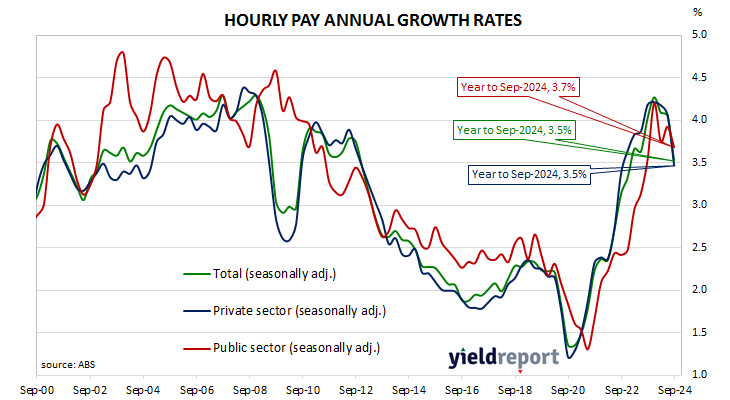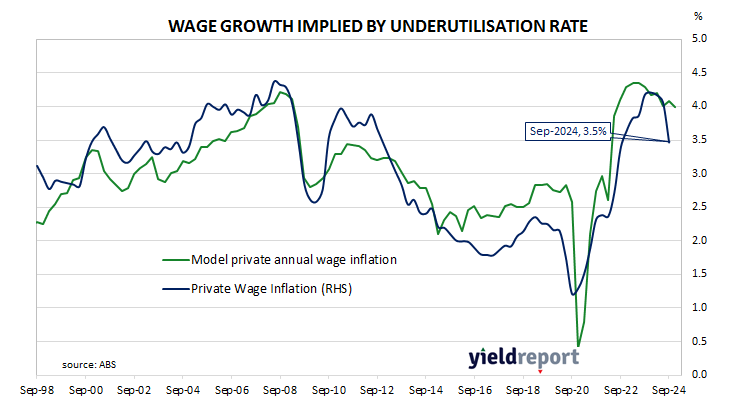Summary: September quarter WPI up 0.8%, slightly below expectations; annual growth rate slows from 4.1% to 3.5%; Westpac: wage inflation slowdown continuing; ACGB yields increase; rate-cut expectations soften; ANZ: points to broad-based slowdown; private sector wages up 3.5% over year, public sector up 3.7%; September underutilisation rate not consistent with slowing wage growth.
After unemployment increased and wage growth slowed during the GFC, a resources investment boom prompted a temporary recovery back to nearly 4% per annum. However, from mid-2013 through to the September quarter of 2016, the pace of wage increases slowed, until mid-2017 when it began to slowly creep upwards. After remaining fairly stable at around 2.2% per annum from September 2018 to March 2020, the growth rate slowed significantly in the June and September quarters of 2020. Growth rates then accelerated over the next three years before stabilising in the latter part of 2023.
According to the latest Wage Price Index (WPI) figures published by the Australian Bureau of Statistics (ABS), hourly wages excluding bonuses grew by 0.8% in the September quarter. The result was slightly below expectations of a 0.9% increase but in line with increases in the previous two quarters. On an annual basis, the growth rate slowed from 4.1% to 3.5%.
“Wage inflation has continued to moderate through 2024, with the six-month annualised pace holding at 3.2% compared to 4.9% in December 2023,” said Westpac senior economist Justin Smirk.
Domestic Treasury bond yields increased significantly across the curve on the day, largely in line with movements of US Treasury yields on Tuesday night. By the close of business, the 3-year ACGB yield had jumped 11bps to 4.22%, the 10-year yield had gained 10bps to 4.68% while the 20-year yield finished 9bps higher at 4.97%.
Expectations regarding rate cuts in the next twelve months softened, with a February cut now viewed as unlikely. Cash futures contracts implied an average of 4.32% in December and 4.30% in February 2025. October 2025 contracts implied 4.05%, 29bps less than the current cash rate.
“The six-month annualised rate was steady at 3.2% and wage growth has slowed across awards, enterprise bargaining agreements and individual arrangements, which points to a broad-based slowdown,” said ANZ senior economist Catherine Birch. “This may give the RBA more confidence that wages growth is returning to a pace consistent with its inflation target band, in the face of continued weakness in productivity growth.”
Wages in the private and public sectors both grew by 0.8% respectively in the quarter. Over the past 12 months, wages in the private sector increased by 3.5% while public sector wages increased by 3.7%. Annual wage growth in the two sectors had been at 4.1% and 3.9% respectively in the June quarter.
The “underutilisation rate” is simply the sum of the unemployment and underemployment rates as per ABS monthly statistics. It has a good correlation with private wage growth two quarters in the future and thus it is useful as a leading indicator even though differences can open up from time to time. September’s underutilisation rate suggests private wage growth may resist further falls in the short-term.
Each quarter the ABS surveys around 3,000 private and public enterprises regarding a sample of jobs in each workplace to measure changes in the price of labour across 18,000 jobs. The results are used to construct the Wage Price Index in a manner similar to the construction of the Consumer Price Index (CPI). Changes in the WPI over time provide a measure of changes in wages and salaries, independently of the type or quantity of work.



